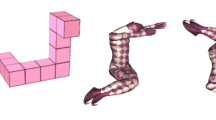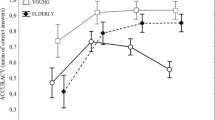Abstract
The present experiment investigated sex differences across stimulus types in a chronometric mental rotation task. The working hypothesis was that human bodies as stimuli would reduce the magnitude of sex differences compared to cubes as stimuli, from the embodied cognition perspective. One hundred and twenty participants, 60 men and 60 women solved chronometric mental rotation items with Shepard–Metzler cube figures, head-cubes, and human bodies, all designed so that they were similar in shape. Two figures of a given stimulus type were presented on the screen and participants had to judge if both items were mirrored or non-mirrored. Results showed better mental rotation performance with human bodies than with other types of stimuli for both sexes, although the effect of stimulus type was more pronounced in men than in women. Furthermore, regardless of stimulus type, men were more accurate than women. Altogether, the results suggest that sex differences are not reduced when human bodies are used as stimuli in a chronometric task. Implications for accounts of sex differences in mental rotations are discussed.





Similar content being viewed by others
Notes
Our choice of data analysis was based on the fact that the use of a percentage as a dependent variable in analysis of variance carries a set of problems, especially when it comes to a valid assessment of interactions (see Dixon, 2008; and Jaeger, 2008 for more details). Considering that the interaction between sex and stimulus type is crucial to our predictions, data were analyzed with logistic mixed linear modeling, as recommended by both Dixon and Jaeger to ensure a proper statistical test of hypotheses. Specifically, following Dixon’s suggestion, a mixed linear model where participants were treated as random effects was computed as it is appropriate to the repeated-measures design used here. The linear mixed-effects model was fit with the glmer program in the lme4 R package (Bates, Maechler, Bolker, & Walker, 2014) using maximum likelihood method for parameter estimation. Furthermore, as recommended by Dixon, incremental models were compared to determine the most parsimonious one (as estimated through the deviance obtained for each model). The mean percentage of correct response is reported in its raw form in the results to facilitate data interpretations.
The approach proposed by Baayen and Milin (2010) for the analysis of response time data was followed. Specifically, mixed linear modeling was applied to the inverse response times with minimal trimming, followed by model criticism (with a cutoff point for residuals above 2.5 standard deviations). For response time, means are reported in their raw form as well as in the transformed inverse form (multiplied by −1000 to preserve scaling) to optimize interpretations of the results.
References
Alexander, G. M., & Evardone, M. (2008). Blocks and bodies: sex differences in a novel version of the mental rotations test. Hormone and Behavior, 53, 177–184. doi:10.1016/j.yhbeh.2007.09.014.
Alexander, G. M., & Son, T. (2007). Androgens and eye movements in women and men during a test of mental rotation ability. Hormones and Behavior, 52, 197–204. doi:10.1016/j.yhbeh.2007.01.011.
Amorim, M. A., Isableu, B., & Jarraya, M. (2006). Embodied spatial transformations: “Body Analogy” for the mental rotation of objects. Journal of Experimental Psychology: General, 135, 327–347. doi:10.1037/0096-3445.135.3.327.
Baayen, R. H., & Milin, P. (2010). Analyzing reaction times. International Journal of Psychological Research, 3, 12–28.
Bates, D., Maechler, M., Bolker B., & Walker, S. (2014). lme4: Linear mixed-effects models using Eigen and S4. R package version 1.1-7. http://CRAN.R-project.org/package=lme4.
Buccino, G., Lui, F., Canessa, N., Patteri, I., Lagravinese, G., Benuzzi, F., … Rizzolatti, G. (2004). Neural circuits involved in the recognition of actions performed by non-conspecifics: an fMRI study. Journal of Cognitive Neuroscience, 16, 114–126. doi:10.1162/089892904322755601.
Calvo-Merino, B., Glaser, D. E., Grèzes, J., Passingham, R. E., & Haggard, P. (2005). Action observation and acquired motor skills: an FMRI study with expert dancers. Cerebral Cortex, 15, 1243–1249. doi:10.1093/cercor/bhi007.
Courvoisier, D. S. (2013). Sex hormones and mental rotation: an intensive longitudinal investigation. Hormones and Behavior, 63, 345–351. doi:10.1016/j.yhbeh.2012.12.007.
Delgado, A. R., & Prieto, G. (2003). The effect of item feedback on multiple-choice test responses. British Journal of Psychology, 94, 73–85. doi:10.1348/000712603762842110.
Dixon, P. (2008). Models of accuracy in repeated-measures designs. Journal of Memory and Language, 59, 447–456. doi:10.1016/j.jml.2007.11.004.
Doyle, R. A., & Voyer, D. (2013). Bodies and occlusion: item types, cognitive strategies, and gender differences in mental rotation. Quarterly Journal of Experimental Psychology, 66, 801–815. doi:10.1080/17470218.2012.719529.
Doyle, R. A., Voyer, D., & Cherney, I. D. (2012). The influence of childhood spatial activities on spatial abilities in adulthood. Journal of Applied Developmental Psychology, 33, 112–120. doi:10.1016/j.appdev.2012.01.002.
Glueck, J., & Fitting, S. (2003). Spatial strategy selection: interesting incremental information. International Journal of Testing, 3, 293–308. doi:10.1207/S15327574IJT0303_7.
Hahn, N., Jansen, P., & Heil, M. (2010). Preschooler’s mental rotation: sex differences in hemispheric asymmetry. Journal of Cognitive Neuroscience, 22, 1244–1250. doi:10.1162/jocn.2009.21236.
Heil, M., & Jansen-Osmann, P. (2008). Sex differences in mental rotation with polygons of different complexity: do men utilize holistic processes whereas women prefer piecemeal ones? The Quarterly Journal of Experimental Psychology, 61, 683–689. doi:10.1080/17470210701822967.
Heil, M., Kavsek, M., Rolke, B., Beste, C., & Jansen, P. (2011). Mental rotation in female fraternal twins: evidence for inter-uterine transfers? Biological Psychology, 86, 90–93. doi:10.1016/j.biopsycho.2010.11.002.
Iwanowska, K., & Voyer, D. (2013). Dimensional transformation in tests of spatial and environmental cognition. Memory and Cognition, 41, 1122–1131. doi:10.3758/s13421-013-0314-9.
Jaeger, T. F. (2008). Categorical data analysis: away from ANOVAs (transformation or not) and towards logit mixed models. Journal of Memory and Language, 59, 434–446. doi:10.1016/j.jml.2007.11.007.
Jansen, P., & Lehmann, J. (2013). Mental rotation performance in soccer players and gymnasts in an object based mental rotation task. Advances in Cognitive Psychology, 9, 92–98. doi:10.2478/v10053-008-0135-8.
Jansen, P., Lehmann, J., & van Doren, J. (2012). Mental rotation performance in male soccer players. Plos ONE, 7(10), 348620. doi:10.1371/journal.pone.0048620.
Jansen-Osmann, P., & Heil, M. (2007). Suitable stimuli to obtain (no) gender differences in the speed of cognitive processes involved in mental rotation. Brain and Cognition, 64, 217–227. doi:10.1016/j.bandc.2007.03.002.
Jolicoeur, P., Regehr, S., Smith, L. B. J. P., & Smith, G. N. (1985). Mental rotation of representations of two-dimensional and three-dimensional objects. Canadian Journal of Psychology, 39, 100–129. doi:10.1037/h0080118.
Jordan, K., Wüstenberg, T., Heinze, H. J., Peters, M., & Jäncke, L. (2002). Women and men exhibit different cortical activation patterns during mental rotation tasks. Neuropsychologia, 40, 2397–2408. doi:10.1016/S0028-3932(02)00076-3.
Kerkman, D. D., Wise, J. C., & Harwood, E. A. (2000). Impossible “mental rotation” problems: a mismeasure of women’s spatial abilities? Learning and Individual Differences, 12, 253–269. doi:10.1016/S1041-6080(01)00039-5.
Lakoff, G., & Johnson, M. (1999). Philosophy in the flesh: The embodied mind and its challenge to Western thought. New York, NY: Basic Books.
Levine, S. C., Vasilyeva, M., Lourenco, S. F., Newcombe, N. S., & Huttenlocher, J. (2005). Socioeconomic status modifies the sex difference in spatial skill. Psychological Science, 16, 841–845. doi:10.1111/j.1467-9280.2005.01623.x.
Linn, M. C., & Petersen, A. C. (1985). Emergence and characterization of sex differences in spatial ability: a meta-analysis. Child Development, 56, 1479–1498. doi:10.1111/j.1467-8624.1985.tb00213.x.
Liuzza, M. T., Setti, A., & Borghi, A. M. (2012). Kids observing other kids’ hands: visuomotor priming in children. Consciousness and Cognition, 21, 383–392. doi:10.1016/j.concog.2011.09.015.
Michelon, P., & Zacks, J. M. (2006). Two kinds of visual perspective taking. Perception and Psychophysics, 6, 327–337. doi:10.3758/BF03193680.
Moè, A., Meneghetti, C., & Cadinu, M. (2009). Women and mental rotation: incremental theory and spatial strategy use enhance performance. Personality and Individual Differences, 46, 187–191. doi:10.1016/j.paid.2008.09.030.
Nazareth, A., Herrera, A., & Pruden, S. M. (2013). Explaining sex differences in mental rotation: the role of spatial activity experience. Cognitive Processing, 14, 201–204. doi:10.1007/s10339-013-0542-8.
Parsons, L. M. (1994). Temporal and kinematic properties of motor behavior reflected in mentally simulated action. Journal of Experimental Psychology: Human Perception and Performance, 20, 709–730. doi:10.1037/0096-1523.20.4.709.
Peters, M., Laeng, B., Latham, K., Jackson, M., Zaiyouna, R., & Richardson, C. (1995). A redrawn Vandenberg & Kuse mental rotation test: different versions and factors that affect performance. Brain and Cognition, 28, 39–58. doi:10.1006/brcg.1995.1032.
Pietsch, S., & Jansen, P. (2012). Different mental rotation performance in students of music, sports and education science. Learning and Individual Differences, 22, 159–163. doi:10.1016/j.lindif.2011.11.012.
Ratcliff, R. (1993). Methods for dealing with reaction time outliers. Psychological Bulletin, 114, 510–532. doi:10.1037/0033-2909.114.3.510.
Shepard, R. N., & Metzler, J. (1971). Mental rotation of three-dimensional objects. Science, 171, 701–703. doi:10.1126/science.171.3972.701.
Shih, M., Pittinsky, T. L., & Ambady, N. (1999). Stereotype susceptibility: identity salience and shifts in quantitative performance. Psychological Science, 10, 80–83. doi:10.1111/1467-9280.00111.
Signorella, M. L., & Jamison, W. (1986). Masculinity, femininity, androgyny, and cognitive performance: a meta-analysis. Psychological Bulletin, 100, 207–228. doi:10.1037/0033-2909.100.2.207.
Thomas, J. R., & French, K. E. (1985). Gender differences across ages in motor performance: a meta-analysis. Psychological Bulletin, 98, 260–282. doi:10.1037/0033-2909.98.2.260.
Titze, C., Heil, M., & Jansen, P. (2008). Gender differences in the mental rotations test (MRT) are not due to task complexity. Journal of Individual Differences, 29, 130–133. doi:10.1027/1614-0001.29.3.130.
Uttal, D. H., Meadow, N. G., Tipton, E., Hand, L. L., Alden, A. R., Warren, C., & Newcombe, N. S. (2013). The malleability of spatial skills: a meta-analysis of training studies. Psychological Bulletin, 139, 352–402. doi:10.1037/a0028446.
Vandenberg, S. G., & Kuse, A. R. (1978). Mental rotation, a group test of three-dimensional spatial visualization. Perceptual and Motor Skills, 47, 599–604. doi:10.2466/pms.1978.47.2.599.
Voyer, D. (2011). Time limits and gender differences on paper-and-pencil tests of mental rotation: a meta-analysis. Psychonomic Bulletin and Review, 18, 267–277. doi:10.3758/s13423-010-0042-0.
Voyer, D., Butler, T., Cordero, J., Brake, B., Silbersweig, D., Stern, E., & Imperato-McGinley, J. (2006). The relation between computerized and paper-and-pencil mental rotation tasks: a validation study. Journal of Clinical and Experimental Neuropsychology, 28, 928–939. doi:10.1080/13803390591004310.
Voyer, D., & Hou, J. (2006). Type of items and the magnitude of gender differences on the mental rotation test. Canadian Journal of Experimental Psychology, 60, 91–100. doi:10.1037/cjep2006010.
Voyer, D., Voyer, S., & Bryden, M. P. (1995). Magnitude of sex differences in spatial abilities: a meta-analysis and consideration of critical variables. Psychological Bulletin, 117, 250–270. doi:10.1037/0033-2909.117.2.250.
Wilson, M. (2002). Six views of embodied cognition. Psychonomic Bulletin and Review, 9, 625–636. doi:10.3758/BF03196322.
Acknowledgments
This research was supported by a Natural Science and Engineering Research Council of Canada to D. Voyer. We are grateful to Dr. Michel-Ange Amorim for providing the stimuli used here. Furthermore we thank Andre Buchner, Marcus Schuster, and Maximilan Vollath for their assistance with data collection, as well as Jennifer Lehmann for programming the mental rotation task. Finally, the authors are thankful to Susan D. Voyer for her helpful comments on an earlier draft of this paper.
Author information
Authors and Affiliations
Corresponding author
Rights and permissions
About this article
Cite this article
Voyer, D., Jansen, P. Sex differences in chronometric mental rotation with human bodies. Psychological Research 80, 974–984 (2016). https://doi.org/10.1007/s00426-015-0701-x
Received:
Accepted:
Published:
Issue Date:
DOI: https://doi.org/10.1007/s00426-015-0701-x




